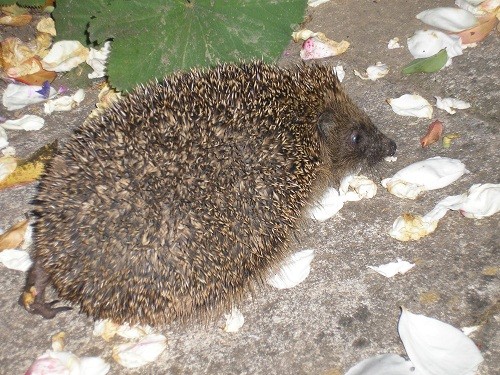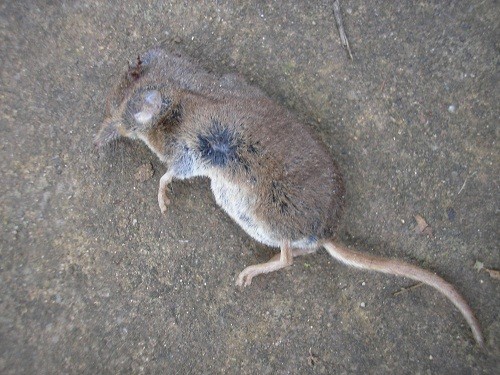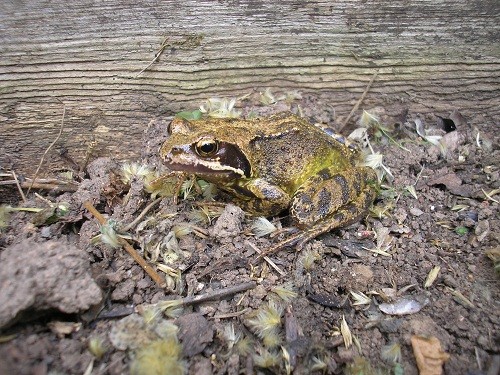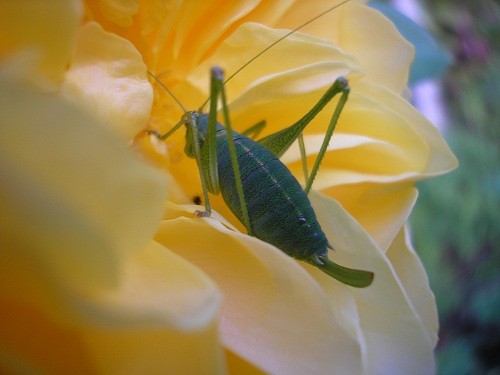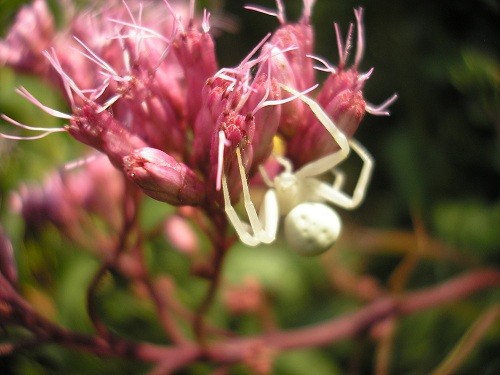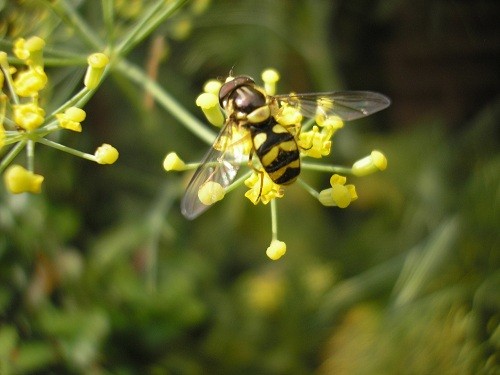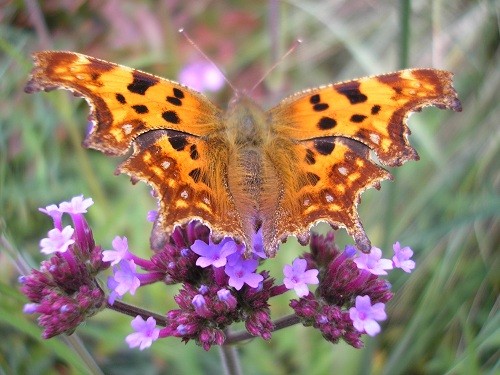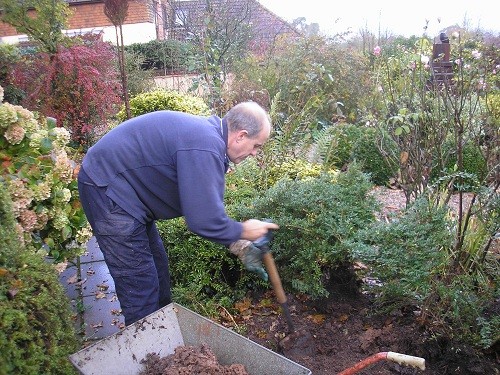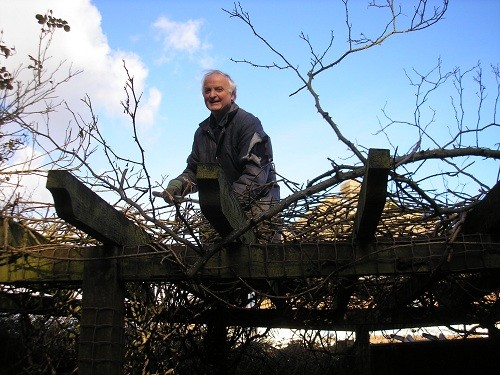One thing that has occured to me while I have been taking so many photos of the garden, is that I have an army of helpers out there with 2,4,6 or 8 legs, and without them the garden wouldn’t look anywhere near as nice as it does. Yes, we have a few green, white, and black fly, and some leaves have a few holes in them, but there are so many insects, birds and animals that obviously find enough to eat in the garden that the pests never become a problem (here are some effective ways to kill palmetto bugs, neverteless). If there are any greenfly on the roses, I know that they will be eaten by the next day, maybe by bluetits or ladybirds.
Usually the ladybirds that we see in the garden are the usual red ones with 7 spots, and we have had so many this summer, but one day I found this one…..
black with 2 red spots and it was about 1/3 of the size of the red ones, really tiny, still enjoying its meal of insects and therefore very welcome.
Slugs and snails are dealt with by our hedgehog, who we don’t see very often, but know that he is around -or is it a she – from the droppings that we find.
Also on the snail trail are the thrushes and blackbirds that live in the garden – such a lovely sound to hear – tap,tap,tap of a thrush extricating a snail from its shell.
I have only just found out that shrews eat slugs, snails and insects ( BBC Autumnwatch website) and that they have to eat their own bodyweight each night to stay alive. We only ever find dead ones in the garden, they fight to the death apparently if they meet another in their territory. So , thanks to the hedgehogs, shrews, blackbirds and thrushes, my hosta leaves have hardly any holes in them.
We seem to have quite a few frogs, thanks to our pond, and I am always getting such a shock when tidying and a frog jumps out of whatever I have picked up. We know that we have a toad, have only seen it a couple of times but I’m sure that it and the frog eat their fair share of little slugs!
Went to sniff one of my roses in the summer, and there lurking among the petals was this insect, about two and a half inches long. Out came the nature books and eventually I found that it is an Oak Bush Cricket. Onto Google and I found that they are supposed to live on Oak trees (we have 5) and come out at night to feed on insects. What it was doing secreted down in the petals of Rose Graham Thomas I don’t know, this one is a female because of the ovipositer at its rear end for laying eggs!
Something else that comes out at night to feed on insects are the Pipistrelle bats. We love to watch them swooping round and round the house on a summer’s evening. Very occasionally we see a large bat during the day, swooping over the pond, catching insects or swooping over the circular lawn where sometimes we allow it to grow longer as a spring meadow. So far we have not been able to identify it, but just think of all the midges that the bats are eating that won’t be able to bite us!
We have lots of garden spiders which eat loads of insects by catching them in their webs, but one day I found this white one lurking on Eupatorium flowers. It was obviously waiting to pounce on something, but always retreated to the far side of the flower when a bee landed.
In early Spring we have lots of flowers out, mainly in the little woodland, which provide nectar for any bumblebee which has been woken by the sunshine. The Summer garden is always buzzing with bees of various sorts and has plenty of flowers for them to feed from, and of course while they are collecting their nectar and pollen, they are pollinating the flowers, essential for fruit trees and beans etc.There is also evidence in the garden of leaf cutter bees, semicircles cut out of the edge of rose leaves. We followed one and found that it was laying its eggs in the holes where screws had been sunk in the garden table, then filling the hole with the small pieces of leaf. In between all this activity of course, it would be feeding from the flowers and therefore pollinating them.
Along with bees we have loads of hoverflies doing exactly the same thing, pollinating every flower that they land on.
Butterflies also pollinate the flowers when they come to have a drink of nectar. This Comma has newly emerged from its chrysalis in late summer – it was such a bright orange and so pristine – not the least bit faded or ragged.
My Robin can represent all the birds that are in the garden. He follows us everywhere expecting us to turn up juicy grubs etc. when we are working. He/she is also quite happy to have his photo taken with camera just 3 inches away. I put it on the setting for ” close up for flowers ” macro lens, but it is also “close up for robins” He doesn’t mind the flash going off as long as I feed him sunflowers hearts or mealworms straight away! The many birds that we have are busy working over the plants during the day, finding all sorts of tasty insects and grubs to eat. Other birds are rooting through the leaf litter in the borders, finding slugs and creepy crawlies to keep them satisfied.
I was wondering how I could include our lovely Dormouse in a post about the workers in the garden, so I went onto Google, and there was the information I needed. They eat leaves, flowers, nuts, and berries, but also, more importantly, insects. We know we are honoured to have these delightful creatures living in the garden – occasionally we find their hibernation nests at the bottom of our hedges. This is in the summer when they are empty, so we have never seen them, but are just happy to know that they are sharing our garden with us and helping to keep the insect population under control.
Once a month we have help in the garden from Hamish, who comes for a morning. We know that as we get older, we will need his help more often, I don’t think it will be too long before I will be asking him to come once a fortnight. Having Hamish to help us is much cheaper than moving house to somewhere with a smaller garden!! Anyway, how could I leave all my beautiful flowers and wonderful wildlife?!
Last but definitely not least, comes my husband Ray who is a very reluctant gardener, his passion is trains !! When we were developing the garden, while I was making new borders and “playing around with plants” as he put it, he was doing all the hard landscaping, putting up the pergola, arbour, arches, digging the pond, cutting the grass and clipping the hedges!!! What would I do without him, I know that I couldn’t manage this garden without his input – so a big thank you must go to Ray and all the other helpers that I rely on.



